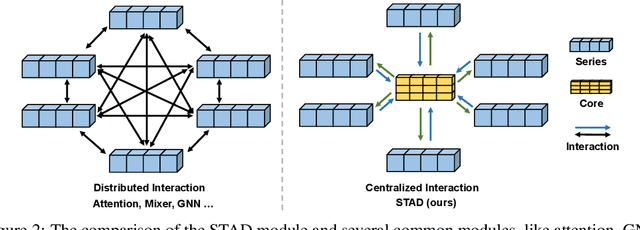Xu-Yang Chen
SeqFusion: Sequential Fusion of Pre-Trained Models for Zero-Shot Time-Series Forecasting
Mar 04, 2025Abstract:Unlike traditional time-series forecasting methods that require extensive in-task data for training, zero-shot forecasting can directly predict future values given a target time series without additional training data. Current zero-shot approaches primarily rely on pre-trained generalized models, with their performance often depending on the variety and relevance of the pre-training data, which can raise privacy concerns. Instead of collecting diverse pre-training data, we introduce SeqFusion in this work, a novel framework that collects and fuses diverse pre-trained models (PTMs) sequentially for zero-shot forecasting. Based on the specific temporal characteristics of the target time series, SeqFusion selects the most suitable PTMs from a batch of pre-collected PTMs, performs sequential predictions, and fuses all the predictions while using minimal data to protect privacy. Each of these PTMs specializes in different temporal patterns and forecasting tasks, allowing SeqFusion to select by measuring distances in a shared representation space of the target time series with each PTM. Experiments demonstrate that SeqFusion achieves competitive accuracy in zero-shot forecasting compared to state-of-the-art methods.
MIETT: Multi-Instance Encrypted Traffic Transformer for Encrypted Traffic Classification
Dec 19, 2024



Abstract:Network traffic includes data transmitted across a network, such as web browsing and file transfers, and is organized into packets (small units of data) and flows (sequences of packets exchanged between two endpoints). Classifying encrypted traffic is essential for detecting security threats and optimizing network management. Recent advancements have highlighted the superiority of foundation models in this task, particularly for their ability to leverage large amounts of unlabeled data and demonstrate strong generalization to unseen data. However, existing methods that focus on token-level relationships fail to capture broader flow patterns, as tokens, defined as sequences of hexadecimal digits, typically carry limited semantic information in encrypted traffic. These flow patterns, which are crucial for traffic classification, arise from the interactions between packets within a flow, not just their internal structure. To address this limitation, we propose a Multi-Instance Encrypted Traffic Transformer (MIETT), which adopts a multi-instance approach where each packet is treated as a distinct instance within a larger bag representing the entire flow. This enables the model to capture both token-level and packet-level relationships more effectively through Two-Level Attention (TLA) layers, improving the model's ability to learn complex packet dynamics and flow patterns. We further enhance the model's understanding of temporal and flow-specific dynamics by introducing two novel pre-training tasks: Packet Relative Position Prediction (PRPP) and Flow Contrastive Learning (FCL). After fine-tuning, MIETT achieves state-of-the-art (SOTA) results across five datasets, demonstrating its effectiveness in classifying encrypted traffic and understanding complex network behaviors. Code is available at \url{https://github.com/Secilia-Cxy/MIETT}.
SOFTS: Efficient Multivariate Time Series Forecasting with Series-Core Fusion
Apr 22, 2024



Abstract:Multivariate time series forecasting plays a crucial role in various fields such as finance, traffic management, energy, and healthcare. Recent studies have highlighted the advantages of channel independence to resist distribution drift but neglect channel correlations, limiting further enhancements. Several methods utilize mechanisms like attention or mixer to address this by capturing channel correlations, but they either introduce excessive complexity or rely too heavily on the correlation to achieve satisfactory results under distribution drifts, particularly with a large number of channels. Addressing this gap, this paper presents an efficient MLP-based model, the Series-cOre Fused Time Series forecaster (SOFTS), which incorporates a novel STar Aggregate-Dispatch (STAD) module. Unlike traditional approaches that manage channel interactions through distributed structures, e.g., attention, STAD employs a centralized strategy. It aggregates all series to form a global core representation, which is then dispatched and fused with individual series representations to facilitate channel interactions effectively. SOFTS achieves superior performance over existing state-of-the-art methods with only linear complexity. The broad applicability of the STAD module across different forecasting models is also demonstrated empirically. For further research and development, we have made our code publicly available at https://github.com/Secilia-Cxy/SOFTS.
Learning Robust Precipitation Forecaster by Temporal Frame Interpolation
Dec 01, 2023Abstract:Recent advances in deep learning have significantly elevated weather prediction models. However, these models often falter in real-world scenarios due to their sensitivity to spatial-temporal shifts. This issue is particularly acute in weather forecasting, where models are prone to overfit to local and temporal variations, especially when tasked with fine-grained predictions. In this paper, we address these challenges by developing a robust precipitation forecasting model that demonstrates resilience against such spatial-temporal discrepancies. We introduce Temporal Frame Interpolation (TFI), a novel technique that enhances the training dataset by generating synthetic samples through interpolating adjacent frames from satellite imagery and ground radar data, thus improving the model's robustness against frame noise. Moreover, we incorporate a unique Multi-Level Dice (ML-Dice) loss function, leveraging the ordinal nature of rainfall intensities to improve the model's performance. Our approach has led to significant improvements in forecasting precision, culminating in our model securing \textit{1st place} in the transfer learning leaderboard of the \textit{Weather4cast'23} competition. This achievement not only underscores the effectiveness of our methodologies but also establishes a new standard for deep learning applications in weather forecasting. Our code and weights have been public on \url{https://github.com/Secilia-Cxy/UNetTFI}.
 Add to Chrome
Add to Chrome Add to Firefox
Add to Firefox Add to Edge
Add to Edge